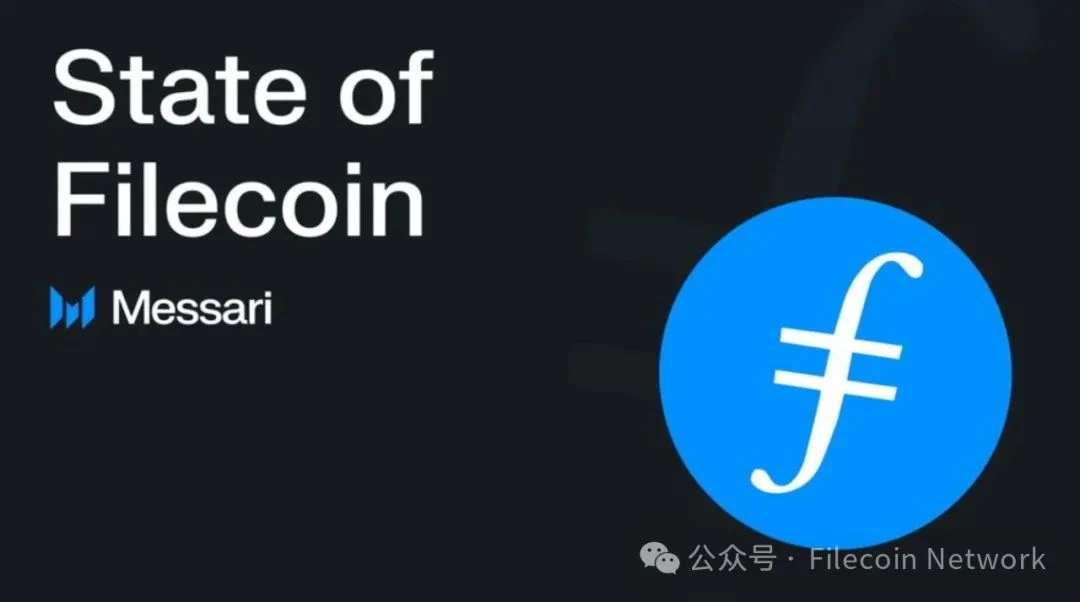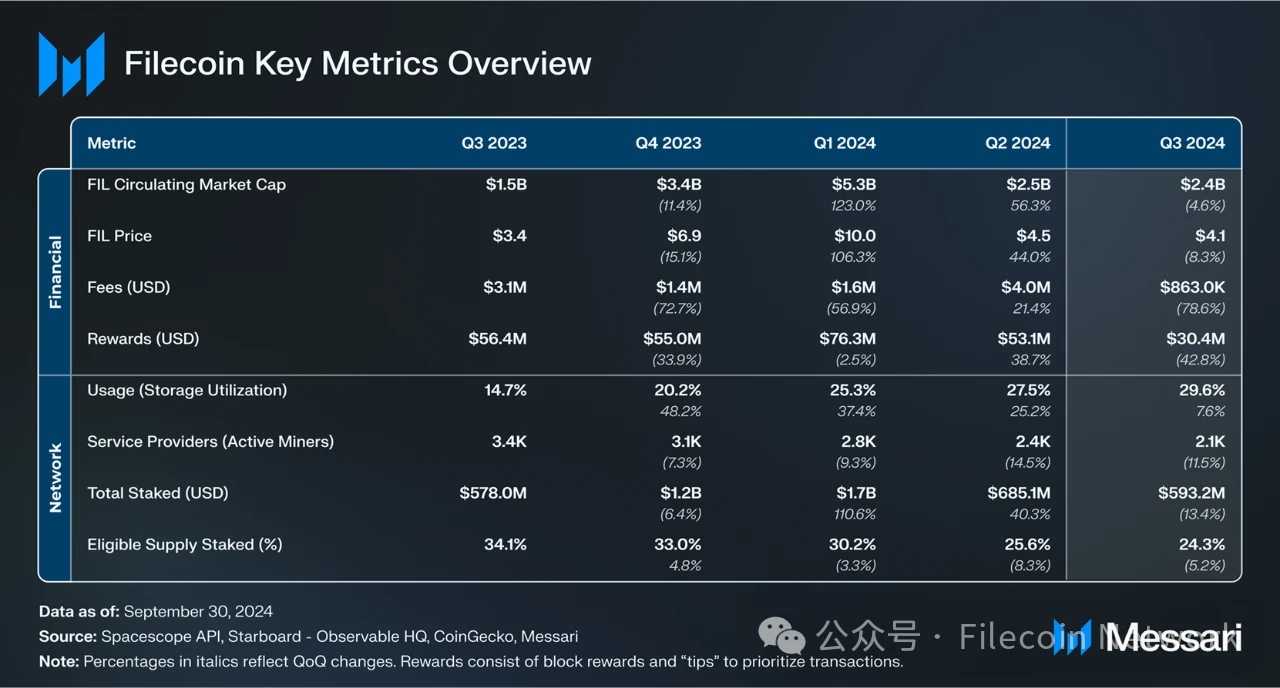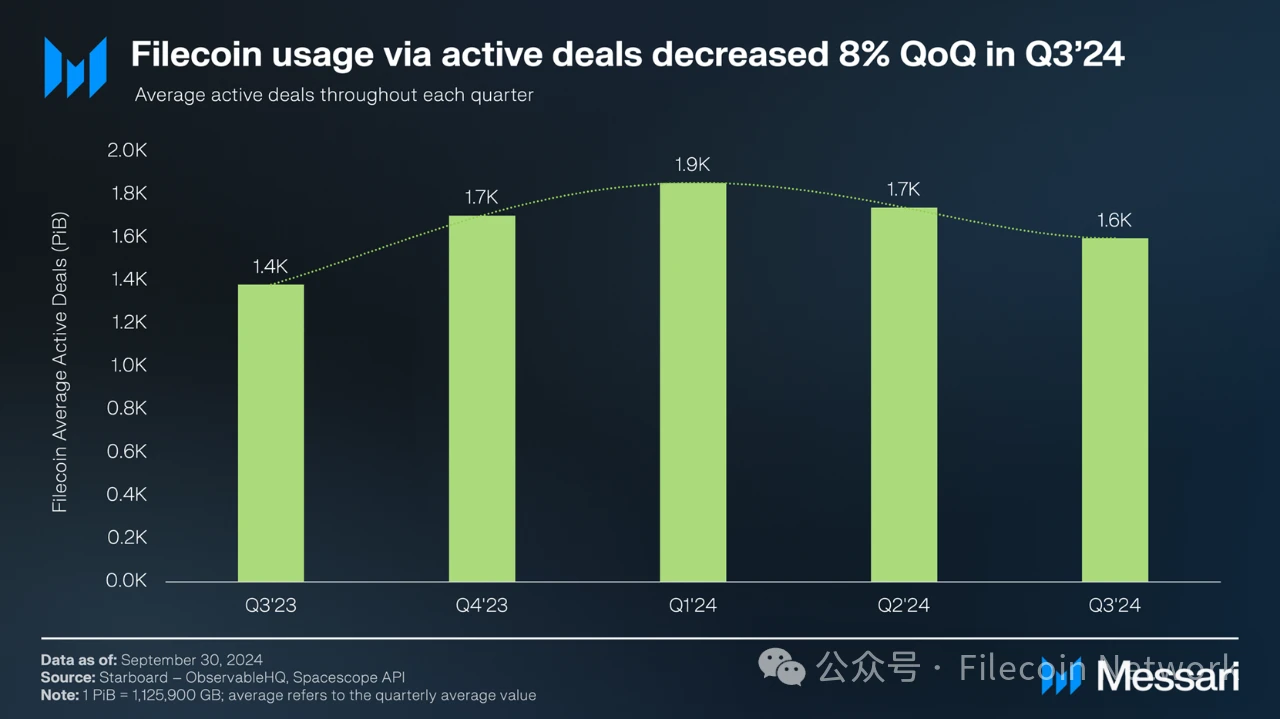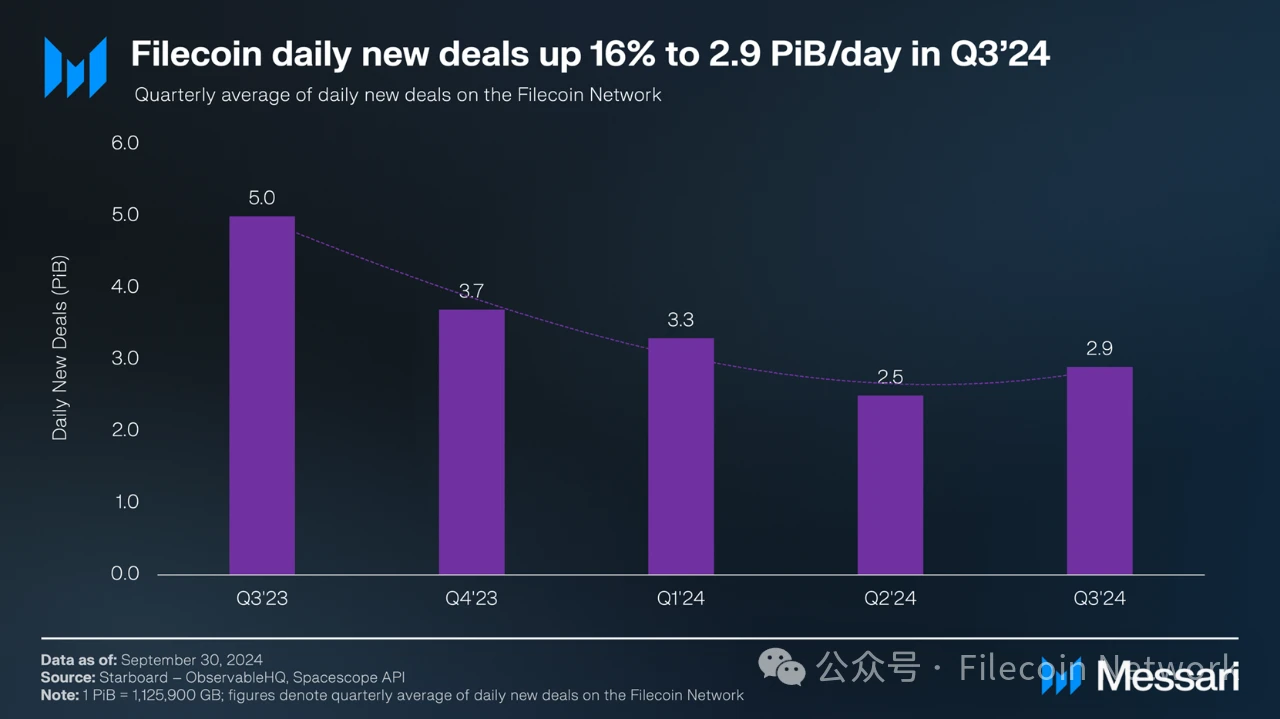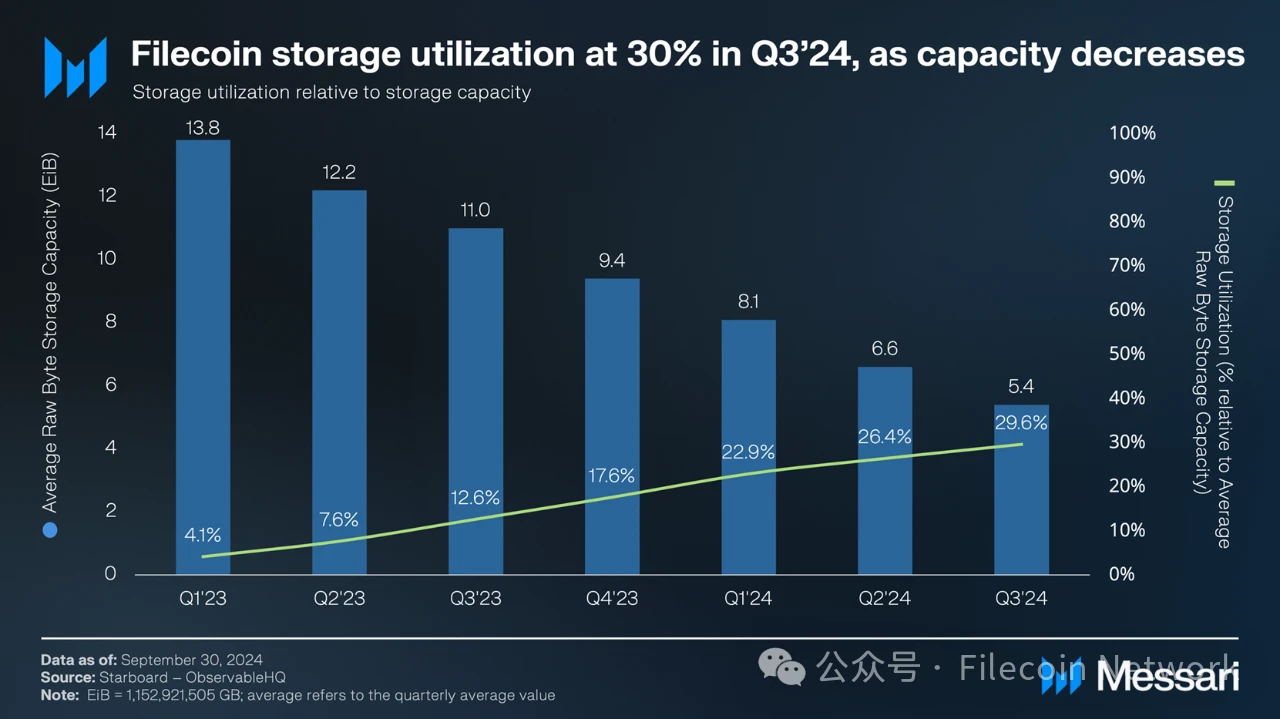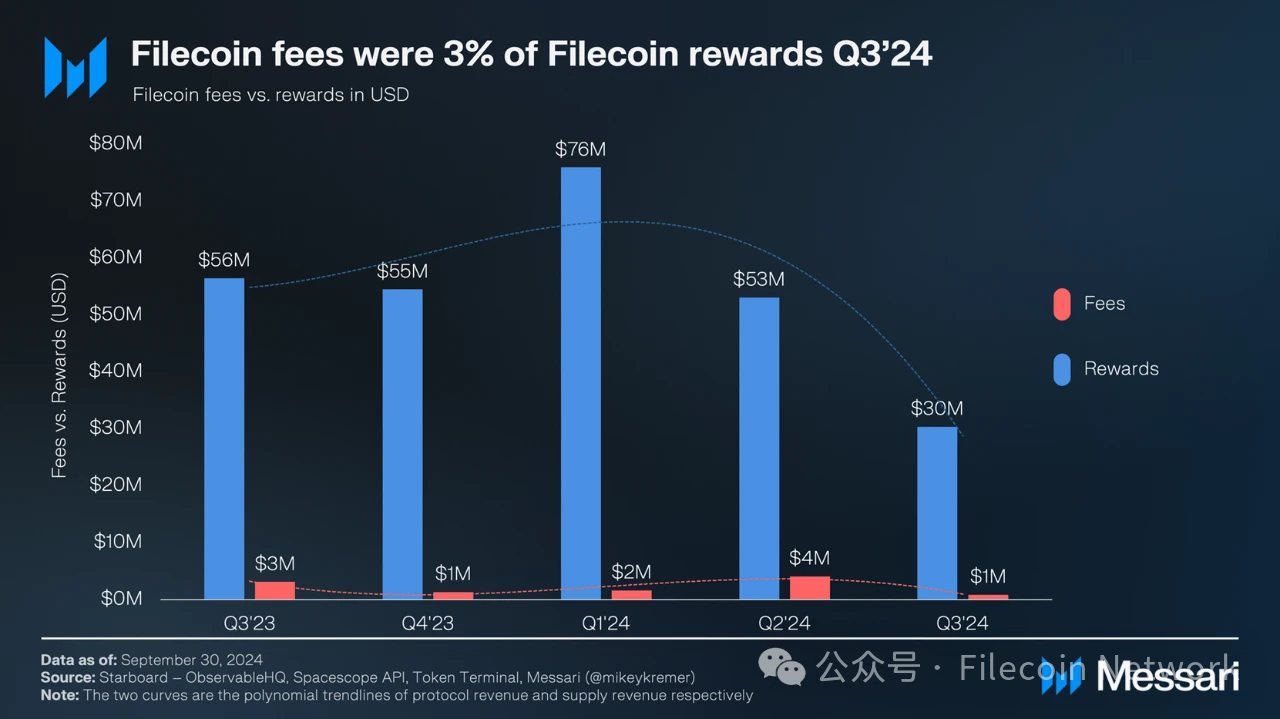原作者: ファイルコインネットワーク
要点
-
第 3 四半期には、 ファイルコインの新規ストレージ取引は前月比16%増加し、ストレージ利用率は第2四半期の26%から第3四半期にはほぼ30%に増加しました。 一方、ストレージ容量は前月比18%減少しました。
-
第3四半期末現在、 2,000 人以上のユーザーが Filecoin にデータセットを保存しており、そのうち 518 人のユーザーが 1,000 TiB を超える大規模なデータセットを保存しています。
-
第3四半期末時点で、4,500以上の独立した契約がFilecoin Virtual Machine(FVM)に導入され、 FVMのDeFi純預金は2000万FILを超えた( 約1兆1,000億8,400万米ドル)で、主に保証、流動性担保、DEXに使用されます。
-
ファイルコインは進化を続け、 分散型物理インフラストラクチャネットワーク (DePIN) 分散型ストレージ市場の創出 企業導入向け およびサポート 分散コンピューティングと人工知能。
-
第 3 四半期には、 Filecoin Network Services (FWS)フレームワークのリリースによりエコシステムが拡大し、 提供する 市場 開発者とユーザー向けの検証可能なサービス。 データソリューションを拡大するために、Filecoin は一連の人工知能パートナーシップを確立しました。
ファイルコインの基本情報
Filecoin はハードウェア マーケットプレイスを作成しています。最初のサービスはストレージです。IPFS (Interplanetary File System) 上に構築された Filecoin は、固定価格体系ではなくプロバイダー市場に基づいてストレージの価格を設定するトランザクションを使用します。ストレージ トランザクションは、サービス レベル契約 (SLA) を伴う契約のようなものです。ユーザーは、指定された期間にデータを保存するためにストレージ プロバイダーに料金を支払います。
データのセキュリティを確保するために、Filecoinは 暗号ゼロ知識証明を通じて定期的にストレージを検証する経済的インセンティブ モデル。ストレージ プロバイダーがストレージ取引に参加するようインセンティブを与えるために、Filecoin はネットワークのネイティブ トークン FIL を報酬として使用します。ストレージ プロバイダーが信頼性の高いオンライン時間を提供できなかったり、ネットワークに対して悪意のあるアクションを実行したりした場合、それに応じて罰せられます。
データを取得するには、Filecoin ユーザーは取得プロバイダーに料金を支払います。オンチェーン トランザクションを伴うストレージ トランザクションとは異なり、取得トランザクションは支払いチャネルを使用してオフチェーンの支払いを決済するため、より迅速な取得が可能になります。ストレージと取得に加えて、Filecoin は、データを実行するためにコンピューティング パワーを契約できるオープン マーケットを提供することを目指しており、従来の集中型システムよりも効率的な代替手段を提供します。
データ コンピューティング サービスを可能にする主要なプロトコル アップグレードには、スマート コントラクト (Filecoin Virtual Machine – FVM) と拡張機能 (Interstellar Consensus) が含まれます。2023 年 3 月に開始される Filecoin Virtual Machine は、Filecoin に Ethereum スタイルのスマート コントラクトを導入し、流動性ステーキング、永久ストレージ、分散コンピューティングなどの新しいユース ケースを促進します。
関連リンク
公式ウェブサイト | X (旧Twitter) | 不和 | スラック
主要な指標
パフォーマンス分析
Filecoin ブロックチェーンは、次の方法でデータストレージを分散化するために使用されます。
-
需要側とは、データストレージを必要とするストレージユーザーを指します。
-
供給側とは、余剰ネットワーク容量を持つストレージ プロバイダーを指します。
ネットワーク
ストレージ ユーザーとストレージ プロバイダー間のアクティブな交換に保存されるデータの量によって、Filecoin ストレージの需要が測定されます。
ストレージトランザクション
第 3 四半期、Filecoin ネットワーク上のアクティブなトランザクション量は 1,600 PiB を超え、前四半期から 8% 減少しました。Filecoin の現在の焦点は、企業での採用を増やし、永久アーカイブ、データ プライバシー、Web2 および Web3 アプリケーションとの統合など、データ サービスに関する新しいユース ケースを開始することです。
第 3 四半期、Filecoin ネットワークの 1 日あたりの新規トランザクションは前月比 16% 増加し、2.9 PiB/日になりました。アクティブ トランザクションが前月比 8% 減少したことを考えると、新規トランザクションの成長率は現在、期限切れトランザクションの成長率を上回っています。新規トランザクションは、ストレージ容量の減少に対する Filecoin ネットワークの利用率の向上に役立ちます。
ストレージの使用率と容量
Filecoin storage utilization relative to total available capacity increased to nearly 30% in Q3, up from 26% in Q2. While this growth is a positive sign for Filecoin adoption through active storage trading, it must be placed in the context of network capacity.
Filecoin のストレージ容量の平均生バイト数は、第 3 四半期に前四半期比 18% 減少し、5.4 EiB となりました。この指標は、約 2 年前の 2022 年第 2 四半期と第 3 四半期に過去最高の 17 EiB 近くに達して以来、減少傾向にあります。ストレージ容量の減少は、ストレージ プロバイダーの総数の減少にも反映されており、2022 年第 3 四半期に過去最高の 4,100 を超えた後、2024 年第 2 四半期には約 2,400 に減少しました。
ストレージユーザー
Messaris 分散型ストレージ ネットワーク ガイド Filecoin は現在、企業や開発者向けのコールド ストレージ ソリューション (アーカイブやリカバリなど) の提供に適していることが示されており、その競争力のある価格設定により、大量のアーカイブ データを保存するためのコスト効率の高い代替手段を探している従来の企業を引き付けるのに役立ちます。
Filecoin のデータ ストレージ プロバイダーである DeStor は最近、Qamcom DDS と提携して、ストレージ サービスのセキュリティ、堅牢性、拡張性を強化しました。パートナーには YayPal や Fieldstream などのデータ ユーザーが含まれます。YayPal は、主力ゲームで 50 万人を超えるユーザーを抱える Web3 ゲーム スタジオであり、Fieldstream は AI マーケティング分析プラットフォームです。
その他のクライアント側ソリューションの例は次のとおりです。
-
GhostDrive: 暗号化、分散化、新しいストレージ最適化技術を通じてプライバシーとセキュリティを優先することに重点を置いています。
-
Seal: UC Berkeley、Starling Labs、Atlas Experiment Network などの大規模ユーザー向けのストレージ サービスの提供に重点を置いています。
-
Steeldome: エンタープライズ データのアーカイブ、バックアップ、およびリカバリに重点を置いています。
冷蔵保管に加えて、Lighthouse、RIBS、retriv、Flamenco などの企業が提供するソリューションもあります。
第3四半期末時点で、2,034人のユーザーがFilecoinにデータセットを保存しており、そのうち518人のユーザーが大規模なデータセット(ストレージサイズが1,000TiBを超えるデータセット)を保存しています。アクティブなトランザクションを通じて利用を促進するために、FilecoinはCID Gravity、 Titan ストレージと分散型。
Filecoin Client Explorer の統計によると、主要なユーザーには Starling Lab、NFT プラットフォーム OpenSea、レイヤー 1 ネットワーク Solana が含まれます。
Filecoin ネットワークを使用しているその他の注目すべき組織は次のとおりです。
-
ビクター・チャン心臓研究所は研究データを管理し共有しています
-
Democracys Libraryは、インターネットアーカイブが管理終了時に収集したデータセットを保存します。
-
SETI研究所は天文学研究データの保存にFilecoinを使用している
-
カリフォルニア大学バークレー校とシールストレージがストレージ物理学の研究で協力
-
GenRAITはEstuaryを使用して重要なゲノムデータをFilecoinに保存します
-
研究センタースターリングラボは人類の歴史に関する機密デジタル記録を保管している
-
Ewesion(中国で最も急成長しているグラフィックファイルホスト)は、データストレージにFilecoinを使用しています
-
DeSci LabsはFilecoin上の分散型データストレージを使用して、研究を他の研究者が複製し、独立して検証できるようにします。
-
Opscientia (OpSci) は、Filecoin を使用して、世界中の科学者がデータを簡単に共有できるようにしています。
-
デスターとシールストレージは、国立科学財団と業界メンバーが資金を提供する産学連携のサイバースマートと共同で、AIデータ整合性改善研究プロジェクトに取り組んでいます。
Filecoin の注目ユーザーの概要については、こちらをご覧ください。
検索
ホット ストレージの使用例のニーズを満たすために、Filecoin と IPFS の上にさらに多くのレイヤー 2 とプロトコルが作成されています。例:
-
Basin: 分散型 AI/ML に重点を置いています。
-
Akave: 分散型 AI 向けのオンチェーン データ レイクを提供します。
-
ストラーチャ: 以前 ウェブ3 ストレージ、現在はDePIN Gamingに注力しています。
Filecoin と IPFS のコンテンツ配信ネットワーク (CDN) として、Saturn プロジェクトはクローズド テストを完了しました。このプロジェクトは Web3.Storage と統合されており、Storacha ネットワークとしてホット ストレージ レイヤーを構築します。この統合の目的は、高速なストレージと検索のための統合製品とネットワークを作成することです。同時に、Station アプリケーションなどのツールはデスクトップに分散検索機能をもたらし、SPARK および Voyager モジュールはネットワーク上で検索チェックを可能にします。具体的には、Station はアイドル状態のコンピューティング リソースを使用して FIL 報酬を提供します。
FVMの使用
Filecoin Virtual Machine (FVM) は 2023 年第 1 四半期にリリースされ、Filecoin に Ethereum スタイルのスマート コントラクトが導入されました。第 3 四半期末の時点で、4,500 を超える独立したコントラクトが FVM に導入され、300 万件を超えるトランザクションが処理されました。
トークン 多くのFVMアクティビティを推進するDeFiプロトコルであるGLIFが、クエストと呼ばれる参加およびGLIFポイント獲得の新しい方法をユーザーに提供するため、ステーキングおよびリースアクティビティは引き続き成長すると予想されます。これらのクエストは、ソーシャルメディアのやりとりやパートナープロジェクトのコラボレーション(Galxeの最初のクエストやパートナークエストなど)を含むコミュニティ主導のアクティビティを促進するように設計されています。2024年11月25日現在、8,200万を超えるGLIFポイントがGLIFユーザーに配布されており、第4四半期にGLIFトークンと1対1で交換されます。
分散型融資は、FVM のもう 1 つの成長分野です。FILLiquid 融資プラットフォームでは、FIL トークン保有者が預金に対して利息を稼ぎ、ストレージ プロバイダー (SP) に融資を行うことができます。テストネット フェーズ中に 20,000 を超えるユニーク ウォレットに到達した後、プラットフォームは FIG ステーキングを開始しました。これは、ユーザーがプラットフォームのガバナンス トークン FIG をステーキングすることで利回りを獲得できる新製品です。
FVM Explorerによると、第3四半期のFVMの平均DeFi純預金は2,000万FIL(約8,400万米ドル)を超え、主にステーキング、流動性ステーキング、DEXに使用されています。その中で、流動性ステーキングプロトコルGLIFが大部分を占め(第3四半期末までに62%)、続いてSFTプロトコル(10%)、FilFi(10%)、その他(16%)となっています。
一方、FVM DeFiランキングによると、第3四半期のDeFiの平均純借入額は1300万FIL(約$53百万)でした。全体的なリスク回避的な市場環境により、 第3四半期には預金と借入の両方が堅調に推移した。
金融
Filecoins の収益フレームワークは Ethereum に似ており、そのガス システムは EIP-1559 メカニズムに基づいて設計されています。ガス システムはネットワーク料金で構成され、使用されたリソースを補うためにバーンされます。ストレージ ユーザーとストレージ プロバイダーの両方がプロトコル収益を生み出します。
所得
Messari の収益分析によると、Filecoin プロトコルの収益には次の 4 つの項目の合計が含まれます。
-
基本料金 - メッセージの混雑状況に応じて、必要なストレージ証明が決まります。
-
バッチ料金 - 保管証明をバッチでパッケージ化するときに使用されます。
-
過大評価料金 - ガス使用量を最適化するために使用されます。
-
罰金料金 - ストレージ プロバイダーが失敗した場合に課される罰金。
Filecoinの基本料金は前月比11倍の$110,000近くまで増加しました。同時に、没収料金は前月比85%減少して$600,000となり、過去5四半期で最低値に達しました。この動きは、ストレージプロバイダーがサービスの信頼性を向上させたことを示しています。
賞
Filecoin の報酬には以下が含まれます:
-
ネットワークによってストレージプロバイダーに配布されるブロック報酬。
-
「チップ」手数料は取引をスピードアップするために使用されます。
第 2 四半期では、ブロック報酬が供給側収益の 99.9% 以上を占め、チップはわずかな部分を占めるに過ぎませんでした。新しい FIL トークンの鋳造メカニズムは、次の 2 つに依存しています。
-
指数関数的減少モード (合計 30%): 参加を促すため、ブロック報酬は初期段階で最も高くなります。時間の経過とともに、指数関数的に減少します。
-
ベースライン モード (総供給量 70%): ブロック報酬はストレージ容量の増加に応じて分配されます。
これら 2 つのモデルを組み合わせることで、ネットワークの早期ブロック報酬配布期間が終了した後も参加を維持するのに役立ち (指数関数的減少モデルを参照)、ネットワーク ストレージ容量の増加によってネットワークにもたらされる追加の価値に継続的に報酬を与えるのにも役立ちます (ベースライン モデルを参照)。
供給側の報酬は、FIL/USD価格の下落により、第2四半期の$53百万から第3四半期の$30百万に30%減少しました。FIL側では、報酬は第2四半期の900万FILから第3四半期の780万FILに15%減少しました。FIL報酬の発行は、今後数四半期にわたって引き続き減少する可能性があります。将来のFIL発行に関する詳細な議論とさまざまなシミュレーションについては、FIL流通供給に関するMessariの最近の調査を参照してください。
エコシステムの概要
2024 年 9 月現在、Filecoin Ecosystem Explorer には 180 を超える既知のプロジェクトが含まれており、コミュニティ ネットワーク プロジェクトの網羅的ではないデータベースとなっています。Filecoin のエコシステム活動はこれまでデータ ストレージに重点を置いてきましたが、第 3 四半期のエコシステム拡張と AI 統合作業は、分散型 AI、データ管理と分析、ゲーム、通信などの分野のアプリケーションにインフラストラクチャを提供することを目指しています。
データ管理と分析
Lighthouse や Destra などのプロジェクトでは、Filecoin を使用して、1 回限りの支払いで永続的なデータ ストレージを提供しています。Triton One は Old Faithful プロジェクトの初期フェーズを完了し、Solana の元帳履歴をコミュニティで利用できるようにしました。Seal Storage は、安全で長期的なストレージを求める企業や個人に不変のデータ ソリューションを提供しています。Cryptosat は、宇宙ベースのデータ収集と検証を強化することを目指して、安全な検証可能性のために小型衛星を使用しています。
分散型コンピューティングでは、Basin はデータ集約型の分析と運用により、Tableland や WeatherXM などのプラットフォームを強化します。Akave はオンチェーン データ レイクの作成を可能にします。
Filecoin でデータ サービスを提供するその他のプロジェクトには、次のものがあります。
-
Fluence: 開発者が Web3 プロジェクトを拡張できるようにします。
-
Storacha: DePIN Gaming に重点を置いた分散型ホット ストレージ ネットワーク。
-
Ramo Network: アイドル状態のコンピューティングパワーを収益化します。
-
Bagel: GPU リファクタリングと AI インフラストラクチャ。
-
IoTeX: DePIN 用のオープンなモジュール式インフラストラクチャ。
人工知能と機械学習
Filecoin と AI および機械学習アプリケーションの統合における重要な開発は、SingularityNET とのコラボレーションです。このコラボレーションは、検証可能なモデル トレーニングを保証し、倫理的な AI 実践を促進することを目的として、Lighthouse を通じてメタデータを保護することに重点を置いています。
もう一つの重要な開発は、機密解除された CIA データセットを分析するための AI エージェントを開発するための Theoriq AI とのコラボレーションです。このプロジェクトは、AI と分散ストレージを組み合わせて複雑なデータ分析を実行し、100 万件を超えるドキュメントの効率的な調査を可能にすることを目的としています。このコラボレーションの結果、Filecoin ドキュメントと GitHub リポジトリでトレーニングされた Filecoin AI エージェントが誕生しました。
同時に、Filecoin は Eternal AI のモデル ストレージと統合され、EQTY Lab は IPFS と Filecoin を使用して AI モデルの系統を検証し、Bagel Network は GPU 市場と AI インフラストラクチャを提供し、Aethir と Ramo Network はアイドル状態のコンピューティング パワーを収益化し、Nuklai Data はプライベート データ ネットワーク向けのコラボレーション エコシステムを提供します。
消費者
ゲーム業界もFilecoinの機能を活用しています。OP Gamesはゲーム向けのNFT鋳造サービスを提供しており、Fluenceは開発者がWeb3プロジェクトを拡張するのを支援し、Storacha NetworkはDePINゲーム向けの分散型ホットストレージに重点を置いています。 市場 Web3 ストアとマーケットプレイスを作成します。
分散型コミュニケーション
Huddle 01 は、Filecoin のインフラストラクチャを使用した分散型ビデオ会議ソリューションを提供し、安全でプライベートな通信プラットフォームのニーズを満たします。
定性分析
主な進展
第 3 四半期に達成された主要な技術的進歩には、プロトコルのアップグレード、新しいサービス、分散型ストレージとコンピューティングにおける Filecoin の機能を強化するソフトウェアの改善が含まれます。
ファイルコインワッフルアップグレード
ファイルコインワッフル アップグレードは2024年8月6日にリリースされ、ネットワーク効率、セキュリティ、コアインフラストラクチャの改善が導入されました。Waffleアップグレードには、ネットワーク機能の特定の側面に対処する6つのFilecoin改善提案(FIP)が組み込まれています。その中でも、注目すべきものは次のとおりです。
-
FIP-0065 は、組み込みの市場アクターのロックされた残高を除外することでネットワークの循環供給計算を簡素化し、市場取引を必要とせずに直接データコミットメントを可能にします。
-
FIP-0079 は FVM に BLS 集約署名を実装し、スマート コントラクトの相互作用の検証効率を向上させる可能性があります。
-
FIP-0092 は、このアップグレードで非対話型 PoRep (NI-PoRep) プロトコルを導入します。これは、Filecoins 証明システムの変更を表し、新しいストレージ プロバイダーの参入障壁を下げ、ネットワーク効率を向上させる可能性があります。
ファイルコインの高速ファイナリティ (F 3)
Waffle のアップグレードに続いて、Filecoin は Filecoin Fast Finality アップグレードをリリースしました。これは、トランザクションのファイナリティ時間を 1 分未満に短縮し、Filecoin の以前のコンセンサス メカニズムの制限に対処することを目的としています。F3 は 2 つのフェーズで実装されます。
-
最初のフェーズでは、Easy Finality Calculator が導入され、プロトコルを変更することなく既存のデータを使用してファイナライズ時間を約 15 分に短縮しました。
-
第 2 フェーズである F3 では、検証可能な証明書を通じて 1 分以内に最終性を提供することを目指しています。
F3 は、ファイナリティ時間を短縮するように設計された新しいコンセンサス プロトコルを統合します。このハイブリッド アプローチは、ファイナリティ ガジェットと BFT プロトコルを組み合わせて、速度、セキュリティ、およびさまざまな種類の攻撃に対する耐性を向上させます。
開発者にとって、F3 を使用すると、より応答性の高いアプリケーションを作成できます。 交換s は、トランザクションの確認が高速化されることにより、トランザクションの効率が向上するというメリットを得られます。ブリッジ ビルダーは、信頼性が低く、低コストの運用というメリットを得られます。
ファイルコイン ネットワーク サービス (FWS)
Filecoin は、2024 年のブリュッセル サミットで Filecoin Network Services (FWS) の立ち上げを発表し、分散型ストレージを超えてサービスを拡大し、分散型クラウド上で作成されたプロトコル用の構成可能なフレームワークの作成を目指しています。
目標は、統一された課金などのサービスを簡素化し、ストレージの基本コンポーネントの再利用を促進することです。これらの機能は、開発者の参入障壁を下げ、ネットワーク収益を増やし、ネットワーク全体の機能を向上させることに重点を置いています。開発者にとっては、これにより分散型サービスへのアクセスが容易になり、より複雑な分散型アプリケーションの作成が可能になります。ユーザーにとっては、Filecoin ベースのサービスとやり取りする際のよりシームレスなエクスペリエンスを意味する可能性があります。
ロータスソフトウェアアップデート
第 3 四半期には、Filecoin ネットワークとして実装された Lotus ソフトウェアが複数のアップデートを受け、ネットワーク機能の強化、Ethereum 互換性の向上、パフォーマンスとセキュリティの問題への対処に重点が置かれました。主なアップデートは次のとおりです。
-
Lotus V1.27.2 (2024 年 7 月 17 日) では、RPC メソッドが改善され、lib p2p が V 0.35.3 にアップグレードされました。
-
Lotus V1.28.1(2024年7月25日)は、従来のEthereumトランザクションのサポートを含むFilecoin Waffleアップグレードを実装します(FIP-0091)。
-
Lotus V1.28.2 (2024 年 8 月 15 日) では、過剰な帯域幅の使用を引き起こす重大な問題が修正され、F 3 のパフォーマンスが向上します。
-
Lotus V1.29.0(2024年9月2日)では、Ethereum RPC機能が強化されます。
これらのアップデートは、Filecoin の技術的機能の変更を表しており、Ethereum ベースのツールとの相互運用性を強化します。9 月 16 日、Filecoin ネットワークはネットワーク障害を報告し、ビーコン検証の失敗により多くの Filecoin ノードが同期に失敗しました。このインシデントの後、Lotus パッチ V1.28.3 および v1.29.1 がリリースされ、影響を受けたノードは復元され、Filecoin は引き続きネットワークを監視します。
重要なイベント
Grayscales分散型AIファンドに参加する
2024年7月17日にグレイスケールの分散型人工知能ファンドが立ち上げられたことで、Filecoinの機関投資家の認知度が高まっています。このファンドは資格のある投資家に開放されており、Filecoin(FIL)だけでなく、分散型人工知能分野の他の有名なプロジェクトも含まれています。10月25日現在、FILはファンド構成の17%を占めています。
Grayscale Investments の分散型 AI ファンドは、資格のある投資家に開放されており、AI 中心の暗号通貨とブロックチェーン プロジェクトに重点を置いています。このファンドは、分散型 AI インフラストラクチャにおける Filecoin の役割が市場で認められていることを表しています。
開発者サミットとイベント
2024年7月にブリュッセルで2024 Filecoin 開発者サミットが開催されました。このイベントでは、Filecoin プロトコルのコアデータストレージ機能を超えた進化について検討し、ネットワーク機能の潜在的な拡張について指摘しました。主な焦点領域は次のとおりです。
-
Filecoin プロトコルの進化トラックでは、最新の開発、今後の機能、ネットワークの長期ビジョンを検討します。
-
サイバーレジリエンスの構築を目的とした専用のセキュリティ会議。
主要なガバナンス上の決定
Filecoin のガバナンス モデルは第 3 四半期も進化を続け、意思決定プロセスにおける分散化とコミュニティの関与を高めることを目的としたいくつかの開発が行われました。
コミュニティロードマップ
2024 Filecoin 開発サミット中に開催されたコミュニティ ロードマップ ミーティングでは、さまざまなバックグラウンドを持つ参加者が集まり、コミュニティ ロードマップの更新に協力しました。収集されたコミュニティの意見は、Filecoin の将来の開発ロードマップに組み込まれます。
Fil+プログラムの進化
Fil+ イニシアチブは成長を続けており、現在 50 人以上のアクティブなアロケータが DataCap の更新に取り組んでいます。この展開は、Filecoin が、特にネットワーク リソースの管理と割り当ての面で、ガバナンス構造の改善に懸命に取り組んでいることを示しています。
要約する
今年第3四半期、Filecoinの新規ストレージ取引は前月比16%増加しました。ストレージ利用率は第2四半期の26%から第3四半期には30%近くに増加しましたが、ストレージ容量は前月比18%減少しました。第3四半期末の時点で、2,000人以上のユーザーがFilecoinにデータを保存しており、そのうち518人のユーザーが1,000TiBを超える大規模なデータセットを保存しています。4,500を超える独立した契約がFilecoin仮想マシン(FVM)に展開されました。FVM上のDeFis純預金は2,000万FIL(約8,400万米ドル)を超え、主に保証、流動性担保、DEXに使用されています。
Filecoin は、分散型物理インフラストラクチャ ネットワーク (DePIN) として発展を続け、企業に導入される分散型ストレージ市場を創出し、分散型コンピューティングと人工知能を実現します。第 3 四半期には、Filecoin Network Services (FWS) フレームワークのリリースによりエコシステムが拡大し、開発者とユーザーに検証可能なサービスの市場を提供しました。同時に、Filecoin は一連の人工知能パートナーシップを確立し、データ ソリューションを拡張しました。さらに、Filecoin は Waffle アップグレードを実装し、Filecoin Fast Finality (F 3) を発表して、スケーラビリティと効率性の課題に対処しました。
このレポートについて気に入った点、不足している点、その他のアイデアなどがありましたら、こちらにご記入ください。 短縮形 すべてのフィードバックは当社のプライバシーポリシーと利用規約の対象となります。
このレポートはFilecoin Foundationの委託を受けて作成されました。すべてのコンテンツは著者が独自に作成したものであり、Messari, Inc.またはレポートを委託した組織の意見を必ずしも表すものではありません。委託者は編集上の決定やコンテンツに影響を与えることはありません。著者は、このレポートで言及されている暗号資産を保有している可能性があります。このレポートは情報提供のみを目的としており、投資アドバイスではありません。投資の決定を行う前に、独自の調査を行い、独立した財務、税務、または法律アドバイザーに相談してください。資産の過去のパフォーマンスは、将来のパフォーマンスを示すものではありません。 利用規約 詳細についてはこちらをご覧ください。
このレポートのいかなる部分も、Messari® の書面による同意なしに、いかなる方法でもコピー、複写、複製、配布することはできません。
この記事はインターネットから引用したものです: Messari レポート: Filecoin 2024 Q3 ステータスレポート
原作者:Grapefruit、ChainCatcher 最近、期待の高かったモジュラーブロックチェーンCelestiaが信頼の危機に陥っています。公表された$1億の資金調達は、実際にはコインの店頭(OTC)販売であり、大量のロック解除へのカウントダウン中に発表されました。この一連の混乱した操作により、主要なモジュラーパブリックチェーンであるCelestiaは世論の最前線に立っています。コミュニティはCelestiaの行動に疑問を呈し、彼らがVCや機関と共謀して通貨の価格を引き上げ、それを販売する機会を利用していた可能性があります。ロック解除の数日前に、彼らは通貨のOTC販売による収益を資金調達ニュースとして発表して有利な状況を作り出し、情報操作などの手段を使用して個人投資家を誘導しました…
